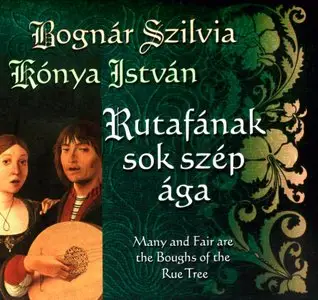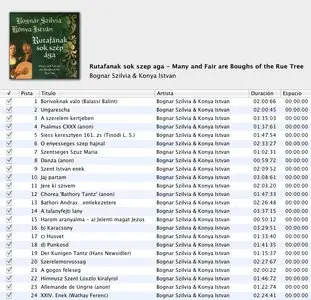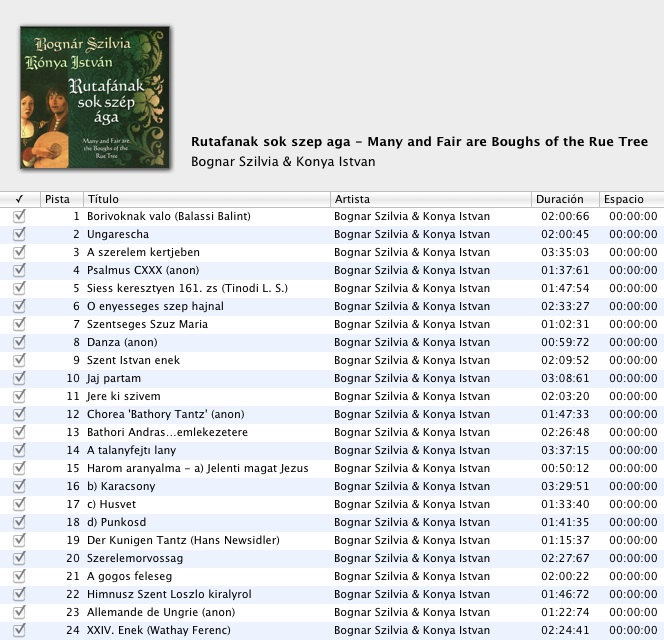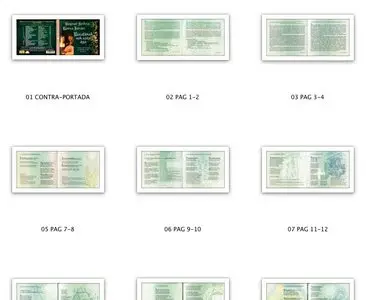Bógnar Szilvia & Kónya István - Rutafának sok szép ága (Many and Fair are Boughs of the Rue Tree)
EAC Rip | FLAC + CUE + LOG | Covers in 300dpi | 241mb
Genre: Renaissance | Label: Gryllus GCD 071 | Original release: 1997
1. Balassi Bálint: Borivóknak való / Song for Wine-bibbers
2. Ungarescha
3. A szerelem kertjében / In the Garden of Love
4. Anon: Psalmus CXXX
5. Tinódi Lantos Sebestyén: Siess keresztyén 161. zs. / Psalm Nr. 161
6. Ó fényességes szép hajnal / Beautiful dawn
7. Szentséges Szűz Mária / Song about the Holy Mary
8. Anon: Danza
9. Szent István ének / Song about King St. Stephen
10. Jaj pártám / Oh, My Aigrette
11. Jere ki szívem / Come, My Darling
12. Anon: Chorea (Bathori Tantz)
13. Báthori András, az erdélyi fejedelem emlékezetére / Historical lay about Báthori András
14. A talányfejtő lány / The Girl Who Solved the Puzzle
Három aranyalma / Three Golden Apples
15. Jelenti magát Jézus / Jesus Declares Himself
16. Karácsony / Christmas
17. Húsvét / Easter
18. Pünkösd / Pentecost
19. Hans Newsidler: Der Künigen Tantz
20. Szerelemorvosság / Remedy for lovers
21. A gőgös feleség / The Proud Wife
22. Himnusz Szent László királyról / Hymn about King St. Ladislaus
23. Anon: Allemande de Ungrie
24. Wathay Ferenc: XXIV. Ének / th Song
EAC Rip | FLAC + CUE + LOG | Covers in 300dpi | 241mb
Genre: Renaissance | Label: Gryllus GCD 071 | Original release: 1997
1. Balassi Bálint: Borivóknak való / Song for Wine-bibbers
2. Ungarescha
3. A szerelem kertjében / In the Garden of Love
4. Anon: Psalmus CXXX
5. Tinódi Lantos Sebestyén: Siess keresztyén 161. zs. / Psalm Nr. 161
6. Ó fényességes szép hajnal / Beautiful dawn
7. Szentséges Szűz Mária / Song about the Holy Mary
8. Anon: Danza
9. Szent István ének / Song about King St. Stephen
10. Jaj pártám / Oh, My Aigrette
11. Jere ki szívem / Come, My Darling
12. Anon: Chorea (Bathori Tantz)
13. Báthori András, az erdélyi fejedelem emlékezetére / Historical lay about Báthori András
14. A talányfejtő lány / The Girl Who Solved the Puzzle
Három aranyalma / Three Golden Apples
15. Jelenti magát Jézus / Jesus Declares Himself
16. Karácsony / Christmas
17. Húsvét / Easter
18. Pünkösd / Pentecost
19. Hans Newsidler: Der Künigen Tantz
20. Szerelemorvosság / Remedy for lovers
21. A gőgös feleség / The Proud Wife
22. Himnusz Szent László királyról / Hymn about King St. Ladislaus
23. Anon: Allemande de Ungrie
24. Wathay Ferenc: XXIV. Ének / th Song
Exact Audio Copy V0.99 prebeta 3 from 28. July 2007
EAC extraction logfile from 20. May 2010, 7:24
Bogn·r Szilvia - KÛnya Istv·n / Rutaf·nak sok szÈp ·ga
Used drive : PIONEER DVD-RW DVR-107D Adapter: 1 ID: 0
Read mode : Secure
Utilize accurate stream : Yes
Defeat audio cache : Yes
Make use of C2 pointers : No
Read offset correction : 48
Overread into Lead-In and Lead-Out : No
Fill up missing offset samples with silence : Yes
Delete leading and trailing silent blocks : No
Null samples used in CRC calculations : No
Used interface : Installed external ASPI interface
Used output format : User Defined Encoder
Selected bitrate : 768 kBit/s
Quality : High
Add ID3 tag : No
Command line compressor : C:\Program Files\Exact Audio Copy\FLAC\FLAC.EXE
Additional command line options : -6 -V -T "ARTIST=%a" -T "TITLE=%t" -T "ALBUM=%g" -T "DATE=%y" -T "TRACKNUMBER=%n" -T "GENRE=%m" -T "COMMENT=%e" %s -o %d
TOC of the extracted CD
Track | Start | Length | Start sector | End sector
––––––––––––––––––––––––––––-
1 | 0:00.00 | 2:00.66 | 0 | 9065
2 | 2:00.66 | 2:00.45 | 9066 | 18110
3 | 4:01.36 | 3:35.03 | 18111 | 34238
4 | 7:36.39 | 1:37.61 | 34239 | 41574
5 | 9:14.25 | 1:47.54 | 41575 | 49653
6 | 11:02.04 | 2:33.27 | 49654 | 61155
7 | 13:35.31 | 1:02.31 | 61156 | 65836
8 | 14:37.62 | 0:59.72 | 65837 | 70333
9 | 15:37.59 | 2:09.52 | 70334 | 80060
10 | 17:47.36 | 3:08.61 | 80061 | 94221
11 | 20:56.22 | 2:03.20 | 94222 | 103466
12 | 22:59.42 | 1:47.33 | 103467 | 111524
13 | 24:47.00 | 2:26.48 | 111525 | 122522
14 | 27:13.48 | 3:37.15 | 122523 | 138812
15 | 30:50.63 | 0:50.12 | 138813 | 142574
16 | 31:41.00 | 3:29.51 | 142575 | 158300
17 | 35:10.51 | 1:33.40 | 158301 | 165315
18 | 36:44.16 | 1:41.35 | 165316 | 172925
19 | 38:25.51 | 1:15.37 | 172926 | 178587
20 | 39:41.13 | 2:27.67 | 178588 | 189679
21 | 42:09.05 | 2:00.22 | 189680 | 198701
22 | 44:09.27 | 1:46.72 | 198702 | 206723
23 | 45:56.24 | 1:22.74 | 206724 | 212947
24 | 47:19.23 | 2:24.41 | 212948 | 223788
Range status and errors
Selected range
Filename C:\fzene\Bogn·r Szilvia - KÛnya Istv·n - Rutaf·nak sok szÈp ·ga.wav
Peak level 100.0 %
Range quality 100.0 %
Test CRC 3DA139BF
Copy CRC 3DA139BF
Copy OK
No errors occurred
AccurateRip summary
Track 1 not present in database
Track 2 not present in database
Track 3 not present in database
Track 4 not present in database
Track 5 not present in database
Track 6 not present in database
Track 7 not present in database
Track 8 not present in database
Track 9 not present in database
Track 10 not present in database
Track 11 not present in database
Track 12 not present in database
Track 13 not present in database
Track 14 not present in database
Track 15 not present in database
Track 16 not present in database
Track 17 not present in database
Track 18 not present in database
Track 19 not present in database
Track 20 not present in database
Track 21 not present in database
Track 22 not present in database
Track 23 not present in database
Track 24 not present in database
None of the tracks are present in the AccurateRip database
End of status report
EAC extraction logfile from 20. May 2010, 7:24
Bogn·r Szilvia - KÛnya Istv·n / Rutaf·nak sok szÈp ·ga
Used drive : PIONEER DVD-RW DVR-107D Adapter: 1 ID: 0
Read mode : Secure
Utilize accurate stream : Yes
Defeat audio cache : Yes
Make use of C2 pointers : No
Read offset correction : 48
Overread into Lead-In and Lead-Out : No
Fill up missing offset samples with silence : Yes
Delete leading and trailing silent blocks : No
Null samples used in CRC calculations : No
Used interface : Installed external ASPI interface
Used output format : User Defined Encoder
Selected bitrate : 768 kBit/s
Quality : High
Add ID3 tag : No
Command line compressor : C:\Program Files\Exact Audio Copy\FLAC\FLAC.EXE
Additional command line options : -6 -V -T "ARTIST=%a" -T "TITLE=%t" -T "ALBUM=%g" -T "DATE=%y" -T "TRACKNUMBER=%n" -T "GENRE=%m" -T "COMMENT=%e" %s -o %d
TOC of the extracted CD
Track | Start | Length | Start sector | End sector
––––––––––––––––––––––––––––-
1 | 0:00.00 | 2:00.66 | 0 | 9065
2 | 2:00.66 | 2:00.45 | 9066 | 18110
3 | 4:01.36 | 3:35.03 | 18111 | 34238
4 | 7:36.39 | 1:37.61 | 34239 | 41574
5 | 9:14.25 | 1:47.54 | 41575 | 49653
6 | 11:02.04 | 2:33.27 | 49654 | 61155
7 | 13:35.31 | 1:02.31 | 61156 | 65836
8 | 14:37.62 | 0:59.72 | 65837 | 70333
9 | 15:37.59 | 2:09.52 | 70334 | 80060
10 | 17:47.36 | 3:08.61 | 80061 | 94221
11 | 20:56.22 | 2:03.20 | 94222 | 103466
12 | 22:59.42 | 1:47.33 | 103467 | 111524
13 | 24:47.00 | 2:26.48 | 111525 | 122522
14 | 27:13.48 | 3:37.15 | 122523 | 138812
15 | 30:50.63 | 0:50.12 | 138813 | 142574
16 | 31:41.00 | 3:29.51 | 142575 | 158300
17 | 35:10.51 | 1:33.40 | 158301 | 165315
18 | 36:44.16 | 1:41.35 | 165316 | 172925
19 | 38:25.51 | 1:15.37 | 172926 | 178587
20 | 39:41.13 | 2:27.67 | 178588 | 189679
21 | 42:09.05 | 2:00.22 | 189680 | 198701
22 | 44:09.27 | 1:46.72 | 198702 | 206723
23 | 45:56.24 | 1:22.74 | 206724 | 212947
24 | 47:19.23 | 2:24.41 | 212948 | 223788
Range status and errors
Selected range
Filename C:\fzene\Bogn·r Szilvia - KÛnya Istv·n - Rutaf·nak sok szÈp ·ga.wav
Peak level 100.0 %
Range quality 100.0 %
Test CRC 3DA139BF
Copy CRC 3DA139BF
Copy OK
No errors occurred
AccurateRip summary
Track 1 not present in database
Track 2 not present in database
Track 3 not present in database
Track 4 not present in database
Track 5 not present in database
Track 6 not present in database
Track 7 not present in database
Track 8 not present in database
Track 9 not present in database
Track 10 not present in database
Track 11 not present in database
Track 12 not present in database
Track 13 not present in database
Track 14 not present in database
Track 15 not present in database
Track 16 not present in database
Track 17 not present in database
Track 18 not present in database
Track 19 not present in database
Track 20 not present in database
Track 21 not present in database
Track 22 not present in database
Track 23 not present in database
Track 24 not present in database
None of the tracks are present in the AccurateRip database
End of status report
One can only marvel at the huge number of melodies and texts from past centuries that have been preserved by folk tradition. 20th-century folk music collections abound with songs already known from earlier written sources, e.g. the Peer-, Paix-, Kájoni-, Vietorisz-codices, 17th-century songbook manuscripts, the Vásárhely Daloskönyv, different psalm collections, the Énekes poézis, 'Sung Poetry' of Pálóczi H. Á, etc.. The number of 16th-century and later texts available has also increased recently. A large number of detailed descriptions of the manifold character of the different musical eras, as well as the birth and changes and eventual disappearance of particular melody types are being published these days.
With this recording we wish to present an illustration of these recent findings. For this purpose we have selected historical examples (composed- as well folk-musical pieces) which date back as early as the 16th century. These songs demonstrate the richness of Hungarian musical tradition, at the same they drawing our attention to the ever so intriguing dynamism and inseparability of preservation and change, as well as the relationship between certain musical trends and genres. Since secular and sacred music were drawing from same the cultural and musical traditions for centuries, and after their separation they coexisted in continuous interaction, the diversity of the genres is surprisingly great.
Our selection includes:
- verse-chronicles and historical songs;
- religious folk songs, archaic folk prayers, psalm translations;
- poems of Sebestyén Tinódi Lantos, Ferenc Wathay and Bálint Balassi;
- samples of the different genres of the sung-poetry in manuscripts; love- or flower-songs, entertaining and wedding songs;
- folk songs (mainly match-making songs);
- traditional and ritual Christmas-, Easter- and Pentecost songs;
- folk ballads.
They all spring from one root - like branches of an old ramous tree…Bognár Szilvia
The lute and its playing technique spread into Europe from the Near-East after the Arab invasion of the Iberian Peninsula and Sicily. The predecessor of the lute was the ud (oud), which means 'wood' or 'made of wood'. The European names of this instrument derive from this word (Al'úd, luth, lute, liuto, Laute). The ud is a folk instrument still widely used in the Arab world. The Medieval lute kept the ancient plucking technique with a plectrum until the 15th century. It was chiefly used in ensembles or to accompany singing. By the 16th century it already had 6 double strings and was plucked by the fingers, used as a solo instrument suitable for polyphonic music. The lute was considered to be second only to human voice, and was referred to as 'the queen of all musical instruments'.
The tradition of singing accompanied by a plucked instrument goes back to ancient times. By the Renaissance the lute became the most popular instrument for accompaniment. The name of the composed lute-songs varied from nation to nation (frottola, villanelle, Lauten-Lieder, air de cour, romance, villancico, ayre). In Eastern Europe, the accompaniment of the songs was not set, they were performed as improvisations, so the lute part on this recording have not been composed, they merely represent one of the countless possible renderings changing from time to time. The Hungarian regős-es, igric-es of the Middle Ages, as well as their successors, the story singers and the song-tellers mainly used plucked instruments as their accompaniment (lute or cobuz). The collected historical songs of Sebestyén Tinódi in the Cronica (1554) represent the first set of composed music of national importance, synthesizing contemporary folk, ecclesiastical and art-music.
Solo lute pieces associated with Hungarian traditions have been mostly preserved in anonymous foreign historical sources. Hans Newsidler (1505/10-1563) was born and raised in Pozsony/Bratislava - now in Slovakia. In about 1530, his family moved to Nürnberg/Germany, where he was to become one of the most important lutenists of the German Renaissance.Kónya István
Thanks to my good hungarian friend Sunniva







